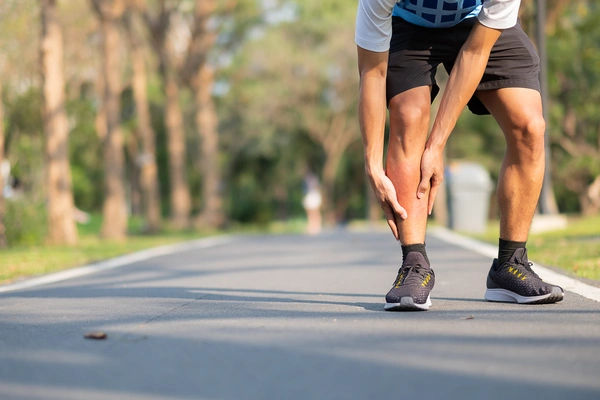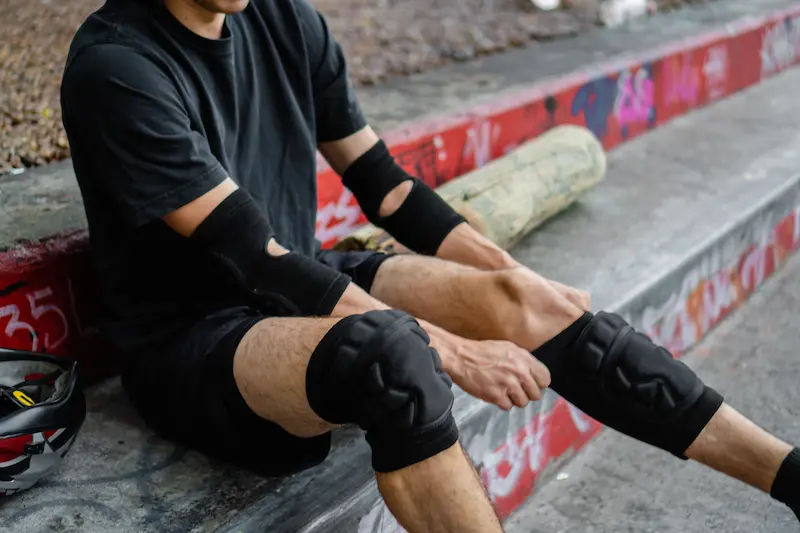Guide to How You Can Avoid Running Injuries
Know about how running cam lead to injuries, prevention of injuries, injury insurance, techniques to treat injury and more.

Written by Dr. Rohinipriyanka Pondugula
Reviewed by Dr. Md Yusuf Shareef MBBS
Last updated on 22nd Oct, 2025

Introduction
If you run long enough, you’ll likely encounter aches—and sometimes injuries. The goal isn’t to fear movement; it’s to run smarter so you can run longer. This practical guide explains exactly how to avoid running injuries using strategies that work in the real world. We’ll cover why injuries happen in the first place, how to build mileage without overloading your body, the form tweaks that protect your joints, strength and mobility essentials, smarter shoe choices, and the recovery habits that quietly reduce risk. You’ll also get quick, targeted tips for common injuries like shin splints, runner’s knee, IT band pain, plantar fasciitis, and Achilles issues. If pain persists despite these steps, we’ll explain when to seek help. Let’s build a running routine that’s resilient, enjoyable, and notably lighter on injuries.
Consult Top General Practitioner for Personalised Advice
Why Running Injuries Happen: The Load vs. Capacity Model
Running injuries are mostly overuse injuries: tissue stress accumulates when training load (how much, how hard, how fast you change it) exceeds tissue capacity (what your body can currently tolerate). Annual injury incidence for runners ranges widely—often 20–80% depending on definition and population—because training errors, prior injuries, and sudden spikes are common [2][9]. Think of capacity as a bank account: sleep, strength, nutrition, and gradual exposure make deposits; hard runs, hills, new shoes, and life stress make withdrawals. Injury risk rises when the withdrawals outpace deposits, especially after sudden changes.
Common Running Injuries at a Glance
- Patellofemoral pain (“runner’s knee”): kneecap pain with stairs or hills.
- Medial tibial stress syndrome (shin splints): along the inner shin.
- IT band syndrome: outer knee pain, especially downhill.
- Plantar fasciitis: first-step heel pain in the morning.
- Achilles tendinopathy: tendon pain is worse with speedwork.
- Stress reactions/fractures: localised bone pain, often tibia, metatarsals, femoral neck, pelvis.
Risk Factors You Can Change vs. Those You Can’t
- Modifiable: training load spikes, weak calf/hip musculature, poor sleep, insufficient fueling, abrupt shoe or terrain changes, low cadence, limited ankle dorsiflexion.
- Nonmodifiable: prior injuries (strongest predictor), age, sex-specific factors (e.g., bone stress risk), anatomy. The win: focusing on modifiable risks dramatically shifts odds in your favor.
Build Smart: Training Progression That Protects You
The most common trigger for injuries is a sudden change: new mileage, faster paces, hills, or adding another sport. The “10% rule” (increase no more than 10% per week) is a useful ballpark, but it’s not ironclad or universally evidence-based. What matters more is avoiding abrupt spikes and allowing time for tissue adaptation.
The Problem with the 10% Rule
- It’s too rigid for some and too aggressive for others. If you’re at very low mileage, 10% is tiny; if you’re high-mileage, 10% every week can still be a lot.
- Different tissues adapt at different rates: tendons and bones are slower than muscles and lungs. You might feel cardio-ready for more, but your tendons disagree.
Better approach: increase one “stress” at a time (either volume or intensity, not both), follow a hard easy rhythm, and schedule a lighter “down week” every 3–4 weeks.
Simple Weekly Structure for Safer Progress
- New/busy runner (3 days/week): 2 easy runs + 1 slightly longer run; optional cross-training day.
- Keep most miles conversational.
- Intermediate (4–5 days/week): 3 easy runs + 1 quality session + 1 long run. Keep 80% of weekly time at easy effort (the “80/20” principle has supportive endurance evidence).
- Guardrails:
- Cap long-run increases to ~1–2 km (or 5–10%) on weeks you increase.
- Add hills or speed only after a stable base.
- If your last week felt like an 8/10 effort, take a 6/10 week next.
Technique You Can Trust: Cadence, Form, and Hills
Form needn’t be perfect; it should be efficient and comfortable. One tweak consistently supported by research: increasing cadence (steps per minute) by about 5–10% can reduce loading at the knee and hip, shortening overstride and lowering impact peaks [9]. You don’t need to chase a magic number like 180; instead, find your baseline and nudge it up slightly if you’re a chronic overstrider.
Cadence Tweaks that Lower Joint Load
Measure your cadence during an easy run (most GPS watches show this). If it’s low and you have knee/hip injuries, try increasing by 5% using a metronome or music playlist.
Keep posture tall, lean slightly from ankles, and think “quicker, quieter steps.”
Evidence highlight: Small cadence increases reduced patellofemoral joint stress in lab studies and are a common, low-risk intervention.
Downhills, Braking, and Impact
- Downhill running increases eccentric load and braking forces—prime triggers for IT band syndrome and runner’s knee. Shorten stride, increase cadence, and keep feet landing under your center of mass.
- On steep uphills, maintain effort not pace. Power-walk if needed to control load and avoid calf/Achilles flare-ups.
Strength and Mobility: Your Injury Insurance
Strength training is one of the most effective, underused ways to prevent sports injuries. A large meta-analysis found strength training can reduce sports injuries by roughly 66% and overuse injuries by ~50%. For runners, prioritize the calf–Achilles complex, hips (abductors/extensors), and core. Strong calves can store and release more elastic energy, protecting the knee and foot; strong hips stabilize pelvis and knee to reduce patellofemoral and IT band stress.
What to Strengthen: Calves, Hips, Core
Key exercises (2–3 sets, 8–12 reps, 2–3 days/week):
- Calf raises (straight-knee and bent-knee), progressing to heavy slow reps.
- Single-leg Romanian deadlifts for hamstrings/glute medius.
- Split squats or reverse lunges.
- Hip abduction work (side-lying leg raises, band walks).
- Core anti-rotation drills (Pallof press) and dead bug variations.
Two-Day Strength Template for Busy Runners
- Day A (lower emphasis): Heavy calf raises, split squats, hip airplanes, dead bugs.
- Day B (posterior chain): Single-leg RDL, step-ups, band walks, Pallof press.
- Progress by adding load or slowing tempo. Keep total time to 25–35 minutes.
Mobility That Matters (and What to Skip)
- Do: dynamic warm-ups (leg swings, ankle circles, walking lunges) before runs, especially workouts.
- Maintain: ankle dorsiflexion and hip extension mobility; tight ankles correlate with altered running mechanics and injuries.
- Skip: long static stretches immediately before running; save longer holds for after or separate sessions.
Shoes and Surfaces: Choosing What’s Right for You
There’s no single “best shoe” for everyone. Evidence suggests the “comfort filter” a shoe that feels most comfortable and natural to you may reduce injury risk because your body self-selects what aligns with its mechanics. Rotating between different shoe models during the week can also lower injury risk by varying load patterns across tissues.
The “Comfort Filter” and Shoe Rotation
- Pick shoes that feel comfortable on test runs; don’t force a trend (max-cushion, carbon, or minimalist) if it doesn’t feel right.
- Consider rotating 2–3 different pairs to distribute load. One study found multi-pair rotation was associated with fewer injuries in recreational runners.
- Replace shoes by feel and wear pattern, not a fixed mileage number.
Minimalist Shoes, Orthotics, and Transitions
- Minimalist or carbon-plated shoes change load distribution. Transition gradually (start with short, easy runs) to allow calf–foot and bone adaptation.
- Orthotics can help selected runners (e.g., recurrent PF pain or tibial stress reactions), but should be paired with strength work, not used as the only fix [2][8].
Pain Rules, Early Intervention, and When to See a Doctor
Not all soreness equals injury. Use simple rules to decide when to push, pause, or stop.
The Traffic Light System for Pain
- Green (0–2/10, no worsening during/after): OK to run; monitor.
- Yellow (3–5/10, settles within 24 hours): Reduce volume/intensity; run-walk; add strength and mobility.
- Red (6–10/10, worsens with running or lingers >48 hours): Stop running; switch to pain-free cross-training; consider clinical assessment.
Early Care: From RICE to PEACE & LOVE
Old guidance focused on RICE (rest, ice, compression, elevation). Updated advice PEACE & LOVE emphasizes Protection, Elevation, Avoid anti-inflammatories early, Compression, Education, then Load, Optimism, Vascularization, Exercise [10]. For most soft-tissue injuries, gentle, progressive loading and early return to pain-free movement speed recovery.
Red Flags and Medical Help
Seek medical care if you notice:
- Sharp, localized bone pain that worsens with impact (possible stress reaction/fracture)
- Joint locking, giving way, or swelling
- Night pain, unexplained weight loss, fever, or neurological symptoms
- Pain that persists beyond two weeks despite deloading
If symptoms persist beyond two weeks, consult a doctor online with Apollo 24|7 for further evaluation. If your condition does not improve after trying these methods, book a physical visit to a doctor with Apollo 24|7.
Quick Prevention Tips for Common Injuries
Shin Splints (Medial Tibial Stress Syndrome)
- Gradually increase volume; avoid abrupt hill or speed additions.
- Calf strength and ankle mobility; consider softer surfaces temporarily.
- Check shoes; try slight cadence increase. Long-tail keyword: shin splints prevention tips.
Runner’s Knee (Patellofemoral Pain)
- Strengthen hips (abductors/extensors) and quads; increase cadence by 5%.
- Avoid sudden downhill volume; run on flatter routes during flares.
- Patellar taping can help short term while you strengthen [9]. Long-tail keyword: runner’s knee exercises.
IT Band Syndrome
- Gradual return to downhills; avoid overstriding and excessive hip drop.
- Strengthen glute medius and lateral chain; consider step-down drills.
Plantar Fasciitis
- Morning plantar stretches, calf strength, and gradual return to impact.
- Temporarily reduce barefoot time; consider a slightly stiffer, supportive shoe.
Achilles Tendinopathy
- Heavy slow calf raises (straight and bent knee), 3 times/week.
- Avoid abrupt speedwork/hills; increase cadence slightly to reduce push-off load.
Stress Fractures
- Address under-fueling/REDs risk; add rest days.
- Build gradually after any layoff; consider vitamin D and calcium sufficiency.
- Medical assessment and imaging as needed; walk–run return under guidance [8][9].
Conclusion
Injuries aren’t an inevitable tax on your love of running—they’re a signal that load exceeded capacity. When you understand that simple equation, prevention becomes practical. Progress your training in smooth steps, not leaps. Use easy, evidence-backed cues—like a modest cadence uptick and shorter downhill strides—to lower joint stress. Invest in strength work, especially for your calves and hips, because it pays out across your entire stride. Choose shoes by comfort, rotate pairs, and transition gradually when you try something new. Then plug the leaks most runners ignore: sleep enough, fuel well, and plan recovery days. If pain appears, act early with the traffic light rules and the PEACE & LOVE approach, and don’t hesitate to seek help when symptoms persist or red flags appear. If symptoms do not improve after deloading and basic care, consult a doctor online with Apollo 24|7 or book an in-person visit for tailored guidance. With a simple plan and consistent habits, you can sidestep most injuries, stay on the roads and trails, and keep the joy in your miles—season after season.
Consult Top General Practitioner for Personalised Advice
Consult Top General Practitioner for Personalised Advice

Dr S Lakshmi Narasimha Reddy
General Practitioner
9 Years • MBBS
Kondapur
Singam's Kids Clinic, Kondapur

Dr. Moumita Roy
General Physician/ Internal Medicine Specialist
8 Years • MBBS , MD (Anesthesiology)
Kolkata
VDC Clinic, Kolkata

Dr. Riti Srivastava
General Practitioner
12 Years • MD (Physician)
Gautam Buddha Nagar
Shri Krishna Clinic, Gautam Buddha Nagar

Dr. S. K. Ghosh
General Practitioner
42 Years • MBBS
South Dumdum
Physique, South Dumdum

Dr. Avinash Pasuparthy
General Practitioner
5 Years • MBBS
Visakhapatnam
Apollo Clinic Vizag, Visakhapatnam
Consult Top General Practitioner for Personalised Advice

Dr S Lakshmi Narasimha Reddy
General Practitioner
9 Years • MBBS
Kondapur
Singam's Kids Clinic, Kondapur

Dr. Moumita Roy
General Physician/ Internal Medicine Specialist
8 Years • MBBS , MD (Anesthesiology)
Kolkata
VDC Clinic, Kolkata

Dr. Riti Srivastava
General Practitioner
12 Years • MD (Physician)
Gautam Buddha Nagar
Shri Krishna Clinic, Gautam Buddha Nagar

Dr. S. K. Ghosh
General Practitioner
42 Years • MBBS
South Dumdum
Physique, South Dumdum

Dr. Avinash Pasuparthy
General Practitioner
5 Years • MBBS
Visakhapatnam
Apollo Clinic Vizag, Visakhapatnam
More articles from Sports Injury Prevention
Frequently Asked Questions
How can beginners avoid injuries when starting to run?
Start with run–walk intervals 3 days/week, keep most effort easy, and add only one stressor at a time. Include 2 short strength sessions weekly and choose comfortable shoes. Long-tail keyword: prevent running injuries for beginners.
Does stretching before running prevent injuries?
Do a dynamic warm-up and easy first 10 minutes. Prolonged static stretching is better after or separate from runs. Mobility plus strength is more protective than stretching alone.
What cadence should I aim for to reduce injuries?
There’s no magic number; increase your current cadence by ~5% if you overstride or have knee/hip pain. Test with a metronome or music playlist. Long-tail keyword: increase running cadence safely.
Are max-cushion shoes safer for injuries?
Not necessarily. Comfort and gradual adaptation matter more. Rotate pairs and transition slowly to new models.
When should I see a doctor about running pain?
If pain is sharp, localized, worsening, persists >2 weeks, or you notice swelling, night pain, or neurological symptoms. If symptoms persist beyond two weeks, consult a doctor online with Apollo 24|7 for further evaluation.

